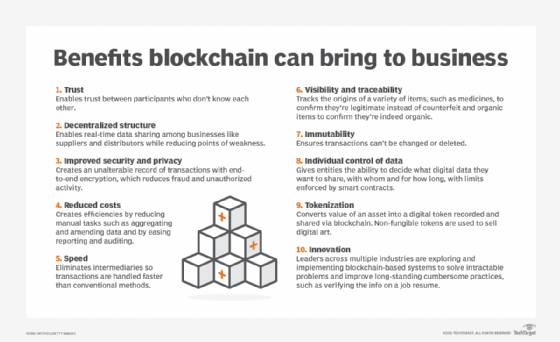Key concepts of public vs. enterprise blockchain
Public and enterprise blockchain have major differences that affect their practicality for specific business applications. Here's what you need to know before deciding.
Although Bitcoin and other cryptocurrencies dominate blockchain discussions, the technology could disrupt far more than the financial sector. Blockchain is also fit for enterprise use. But to fully grasp its potential business value, CIOs and other leaders must first understand the differences between public blockchain and enterprise blockchain as well as the benefits and drawbacks of the latter.
In the broadest terms, blockchain is a distributed ledger technology that records data in a public ledger without requiring third-party validation. Instead, unidentified parties confirm the data's validity using an established consensus method.
What is public blockchain?
Many consumers are familiar with public blockchain, also known as permissionless blockchain. The information on a public blockchain is transactional data stored and distributed on a decentralized, peer-to-peer (P2P) network of computers. Users are pseudo-anonymous and confirm the authenticity of data added to a blockchain by consensus. The blockchain's distributed ledger records the details of transactions in several places, making them accessible at any time.
Well-known public blockchain uses include cryptocurrency and nonfungible tokens. NFTs are assets converted into exclusive, digital representations that exist as unique copies on a blockchain. Consumers can buy, sell and hold NFTs as digital collectibles, with the NFTs authenticating ownership. NFT applications range from trading cards to real estate and artwork.
NFTs and cryptocurrency are examples of decentralized finance. Both use blockchain technology to remove the intermediaries that are needed to process traditional financial transactions.
Two drawbacks of public blockchain are performance and scalability. The system slows down, is costly to support and becomes less sustainable as the number of transactions increases. The transaction volume can also inhibit the ability to scale up quickly. Public blockchain, especially when used for cryptocurrency, also uses an enormous amount of energy.
What is enterprise blockchain?
A key difference between public and enterprise blockchain is their permission levels. To access enterprise blockchain -- also known as private blockchain -- approved users are granted access to a closed network via cryptographic keys that are assigned to them. The blockchain is not open to everyone; the firm that controls the blockchain determines who can view, change or add data on the networked nodes.
A private blockchain also isn't decentralized to the same extent as a public blockchain, though the P2P aspect remains.
Private blockchains are used for both business-to-consumer and business-to-business applications. One type of B2B application, a consortium blockchain, combines features of both public and private blockchains. Rather than using the open system of the public blockchain or the closed system of a private blockchain controlled by a single entity, a consortium blockchain is managed by multiple groups.
Enterprise blockchain's intrinsic privacy limits the ability of outside parties to alter data. However, that doesn't mean it's infallible. Hackers could still exploit a security weakness and gain unauthorized access.
Benefits of enterprise blockchain
Business processes that involve a lot of secure transactions, such as banking, identity management and NFTs, aren't the only ones that can make use of enterprise blockchain. For example, blockchain technology could support supply chain management, hospitality and healthcare operations.
Some other blockchain use cases include the following:
- Drug supply. Cutting down on counterfeit prescription drugs in the supply chain by recording drug types and batch numbers on a blockchain.
- HR. Minimizing the time to process mundane tasks such as confirming job applicant education levels, employment history and other career qualifications.
- Utilities. Automating tasks such as solar energy sales, energy trading between conglomerates and billing for autonomous electric vehicle charging stations.
Because blockchain requires a significant financial and change management investment, it's important to take an in-depth look at how your business handles transactions. For example, automating transactions and other processes via smart contracts, a popular blockchain application, could make them more efficient and secure. As a result, investing in an enterprise blockchain project could solve a current issue and reduce the risk of increasing IT expenditures.

Concerns about enterprise blockchain
IT leaders may choose not to implement enterprise blockchain for various reasons. One is the challenge of being an early technology adopter in a business setting. An enterprise blockchain requires mutual agreement between several entities to share or grant access.
Some leaders are concerned that it's more challenging to achieve trust than with public blockchain because only specific, centralized nodes have the power to do so. Fewer nodes mean less security because a few rogue nodes could compromise the consensus.
Like any software implementation, blockchain requires change management to get all of the participants to adopt unambiguous specifications that help to ensure success.
The specifications may include the following:
- Joint business rules.
- Shared data definitions.
- Legal agreements.
- Adherence to governmental regulations.
Implementation can be more costly and complex than building or maintaining a traditional centralized database. Blockchain as a service, or BaaS, can minimize these costs, but cloud-based architectures can incur expenses in other ways.
IT leaders may encounter considerable internal and external technological weaknesses unique to blockchain. They include vulnerabilities such as stolen cryptographic keys, flawed data input or developer incompetence. There are security issues such as 51% attacks, which occur when a majority takes control of the consensus process.
Employees might worry that enterprise blockchain will take away jobs. The concern is that blockchain will replace administration of routine tasks such as data entry, manual verification and paperwork.
Organizations adopting sustainable practices must consider how those practices could conflict with an enterprise blockchain implementation. The decentralized aspect of blockchain is one of its main selling points. But the software's colossal production of carbon emissions and energy demands will negatively affect environmental, social and governance objectives.
Blockchain adherents and industry watchers are discussing changing the core technology to improve blockchain's carbon footprint. Until that happens, enterprise blockchain may not be ready to support the goals of sustainability-conscious organizations.








